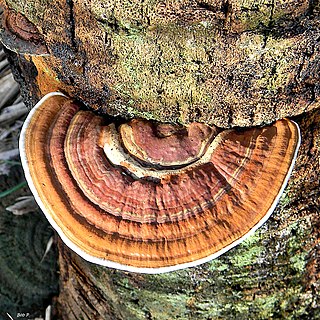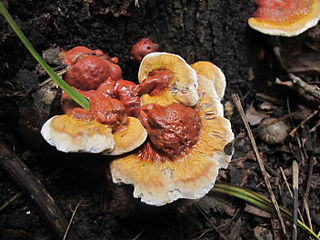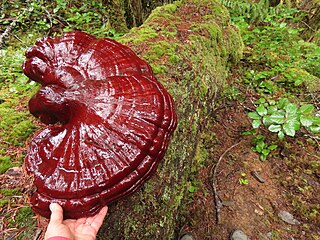
The Polyporales are an order of about 1800 species of fungi in the division Basidiomycota. The order includes some polypores as well as many corticioid fungi and a few agarics. Many species within the order are saprotrophic, most of them wood-rotters. Some genera, such as Ganoderma and Fomes, contain species that attack living tissues and then continue to degrade the wood of their dead hosts. Those of economic importance include several important pathogens of trees and a few species that cause damage by rotting structural timber. Some of the Polyporales are commercially cultivated and marketed for use as food items or in traditional Chinese medicine.

Polypores are a group of fungi that form large fruiting bodies with pores or tubes on the underside. They are a morphological group of basidiomycetes-like gilled mushrooms and hydnoid fungi, and not all polypores are closely related to each other. Polypores are also called bracket fungi or shelf fungi, and they characteristically produce woody, shelf- or bracket-shaped or occasionally circular fruiting bodies that are called conks.

Butt rot is a disease of plants, mostly trees, caused by fungi. The fungus attacks the moist, poorly protected undersurface of tree trunk's thickest part, where the end of the stem makes contact with the soil. It may affect the roots as well, causing a disease known as root rot. It then moves up into the interior of the plant, producing a roughly conical column of dead, rotted plant matter, up to one and a half meters long in severe cases. Such an infection is likely to impair the transport properties of the xylem tissue found at the center of the stem. It also weakens the stem and makes the plant more vulnerable to toppling. One particularly virulent species of fungus associated with butt rot is Serpula himantioides.

Lingzhi, Ganoderma sichuanense, also known as reishi or Ganoderma lingzhi is a polypore fungus native to East Asia belonging to the genus Ganoderma.

Ganoderma applanatum is a bracket fungus with a cosmopolitan distribution.

Ganoderma is a genus of polypore fungi in the family Ganodermataceae that includes about 80 species, many from tropical regions. They have a high genetic diversity and are used in traditional Asian medicines. Ganoderma can be differentiated from other polypores because they have a double-walled basidiospore. They may be called shelf mushrooms or bracket fungi.

Rhodofomes cajanderi is a widely distributed species of bracket fungus. Commonly known as the rosy conk due to its rose-colored pore surface, it causes a disease called a brown pocket rot in various conifer species. It is inedible. It is widespread in western North America, with more prevalence in southern climates. It has a particular preference for higher-altitude spruce forests.

Ganoderma orbiforme – most commonly known as G. boninense or just Ganoderma in oil palm pathology – is a species of polypore fungus that is widespread across southeast Asia. It is a plant pathogen that causes basal stem rot, a disease of the African oil palm. The fungus was first described scientifically in 1838 by Elias Magnus Fries from collections made in Guinea. Leif Ryvarden transferred it to the genus Ganoderma in 2000. In addition to its type locality, the fungus has also been collected from the Bonin Islands in the Pacific, and from Venezuela and Puerto Rico.

Ganoderma zonatum is a plant pathogen that infects the palm species causing butt rot. It is a fungus that infects the bottom 122–152 centimeters of the plant also rotting the roots. It has been known to be in both natural and planted environments and in the majority of cases only in palms.

Gloeoporus dichrous is a species of fungus in the family Irpicaceae. First described as Polyporus dichrous by Elias Magnus Fries in 1815, it was later transferred to the genus Gloeoporus by Italian mycologist Giacomo Bresadola in 1912. The variety G. dichrous var. niger was proposed in 2008, after molecular analysis revealed the two taxa were conspecific. G. dichrous is inedible.

Giacomo Bresadola 14 February 1847 – Trento 9 June 1929) was an eminent Italian mycologist. Fungi he named include the deadly Lepiota helveola and Inocybe patouillardii, though the latter is now known as Inosperma erubescens as this latter description predated Bresadola's by a year. He was a founding member of the Société mycologique de France.
Pseudopiptoporus is a genus of fungi in the family Polyporaceae. It was circumscribed by Norwegian mycologist Leif Ryvarden in 1980 with the type species Pseudopiptoporus devians. This fungus was originally published as Polyporus devians by Giacomo Bresadola in 1920. Pseudopiptoporus chocolatus was added to the genus in 2003.

Ganoderma meredithiae is a species of bracket fungus in the family Ganodermataceae.

Psilocybe medullosa is a species of psychoactive mushroom. It was originally described in 1898 as Naucoria medullosa by Italian mycologist Giacomo Bresadola. Czech mycologist Jan Borovička transferred it to Psilocybe in 2007. A widespread but rather rare species, it is found in Europe, where it grows as a saprobe on woody debris and detritus. Chemical analysis has been used to confirm the presence of the psychedelic compounds psilocin and psilocybin in the fruit bodies but probably at low levels. Psilocybe silvatica is its American sister species; it differs by subtle changes in molecular markers.

Ganoderma sessile is a species of polypore fungus in the Ganodermataceae family. There is taxonomic uncertainty with this fungus since its circumscription in 1902.

Junghuhnia nitida is a widespread species of crust fungus in the family Steccherinaceae.
Amauroderma aurantiacum is a polypore fungus in the family Ganodermataceae. It was first described as a species of Ganoderma by Portuguese botanist Camille Torrend in 1932. Tatiana Gibertoni and Annarosa Bernicchia transferred it to Amauroderma in 2008. A. aurantiacum is found in Brazil and Venezuela.
Scytalidium ganodermophthorum is an anthroconidial ascomycete fungus in the Scytalidium genus. It is also known by its teleomorph name Xylogone ganodermophthora. It is the cause of yellow rot in lingzhi mushrooms and it is used in spalting as a pigmenting fungi.
Anjali Roy was an eminent Indian mycologist and academician. The fungus genus Royoporus is named in her honour.

Ganoderma oregonense is a species of bracket fungus that causes root and butt white rot in conifers in northwestern coastal North America, including California, Oregon, Washington, British Columbia, Yukon, and Alaska. G. oregonense is very similar to Ganoderma tsugae, but G. tsugae is associated with east coast Tsuga (hemlock) rather than west coast conifer. Its been speculated that G. oregonense and G. tsugae might actually be one species, but mycologists just don't know for sure yet.
















